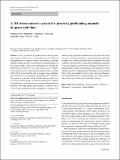| dc.contributor.author | Howland, Jonathan C. | |
| dc.contributor.author | Jensen, Frants H. | |
| dc.contributor.author | Tyack, Peter L. | |
| dc.contributor.author | Macfarlane, Nicholas Blair Wootton | |
| dc.date.accessioned | 2016-09-29T18:23:02Z | |
| dc.date.available | 2016-09-29T18:23:02Z | |
| dc.date.issued | 2015-02 | |
| dc.date.submitted | 2015-02 | |
| dc.identifier.issn | 0340-5443 | |
| dc.identifier.issn | 1432-0762 | |
| dc.identifier.uri | http://hdl.handle.net/1721.1/104438 | |
| dc.description.abstract | Here, we describe a portable stereo camera system that integrates a GPS receiver, an attitude sensor and 3D stereo photogrammetry to rapidly estimate the position of multiple animals in space and time. We demonstrate the performance of the system during a field test by simultaneously tracking the individual positions of six long-finned pilot whales, Globicephala melas. In shore-based accuracy trials, a system with a 50-cm stereo baseline had an average range estimation error of 0.09 m at a 5-m distance increasing up to 3.2 at 50 m. The system is especially useful in field situations where it is necessary to follow groups of animals travelling over relatively long distances and time periods whilst obtaining individual positions with high spatial and temporal resolution (up to 8 Hz). These positions provide quantitative estimates of a variety of key parameters and indicators for behavioural studies such as inter-animal distances, group dispersion, speed and heading. This system can additionally be integrated with other techniques such as archival tags, photo-identification methods or acoustic playback experiments to facilitate fieldwork investigating topics ranging from natural social behaviour to how animals respond to anthropogenic disturbance. By grounding observations in quantitative metrics, the system can characterize fine-scale behaviour or detect changes as a result of disturbance that might otherwise be difficult to observe. | en_US |
| dc.description.sponsorship | United States. Office of Naval Research (Grants N000140910528 and N000141210417) | en_US |
| dc.description.sponsorship | Woods Hole Oceanographic Institution. Marine Mammal Center | en_US |
| dc.publisher | Springer Berlin Heidelberg | en_US |
| dc.relation.isversionof | http://dx.doi.org/10.1007/s00265-015-1890-4 | en_US |
| dc.rights | Article is made available in accordance with the publisher's policy and may be subject to US copyright law. Please refer to the publisher's site for terms of use. | en_US |
| dc.source | Springer Berlin Heidelberg | en_US |
| dc.title | A 3D stereo camera system for precisely positioning animals in space and time | en_US |
| dc.type | Article | en_US |
| dc.identifier.citation | Macfarlane, Nicholas B. W. et al. “A 3D Stereo Camera System for Precisely Positioning Animals in Space and Time.” Behavioral Ecology and Sociobiology 69.4 (2015): 685–693. | en_US |
| dc.contributor.department | Massachusetts Institute of Technology. Department of Biology | en_US |
| dc.contributor.mitauthor | Macfarlane, Nicholas Blair Wootton | |
| dc.relation.journal | Behavioral Ecology and Sociobiology | en_US |
| dc.eprint.version | Author's final manuscript | en_US |
| dc.type.uri | http://purl.org/eprint/type/JournalArticle | en_US |
| eprint.status | http://purl.org/eprint/status/PeerReviewed | en_US |
| dc.date.updated | 2016-08-18T15:24:44Z | |
| dc.language.rfc3066 | en | |
| dc.rights.holder | Springer-Verlag Berlin Heidelberg | |
| dspace.orderedauthors | Macfarlane, Nicholas B. W.; Howland, Jonathan C.; Jensen, Frants H.; Tyack, Peter L. | en_US |
| dspace.embargo.terms | N | en |
| dc.identifier.orcid | https://orcid.org/0000-0001-6731-3392 | |
| mit.license | PUBLISHER_POLICY | en_US |
| mit.metadata.status | Complete | |
